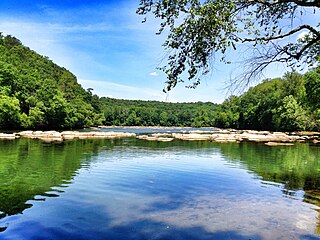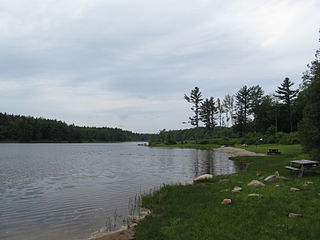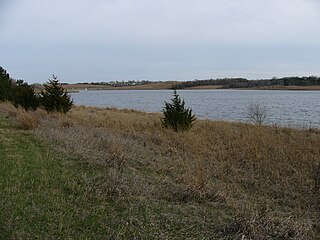
Lake Mead National Recreation Area is a U.S. National Recreation Area located in southeastern Nevada and northwestern Arizona. Operated by the National Park Service, Lake Mead NRA follows the Colorado River corridor from the westernmost boundary of Grand Canyon National Park to just north of the cities of Laughlin, Nevada and Bullhead City, Arizona. It includes all of the eponymous Lake Mead as well as the smaller Lake Mohave – reservoirs on the river created by Hoover Dam and Davis Dam, respectively – and the surrounding desert terrain and wilderness.

Tenkiller Ferry Lake, or more simply, "Lake Tenkiller," is a reservoir in eastern Oklahoma formed by the damming of the Illinois River. The earth-fill dam was constructed between 1947 and 1952 by the United States Army Corps of Engineers for purposes of flood control, hydroelectric power generation, water supply and recreation. It went into full operation in 1953. The lake and dam were named for the Tenkiller family, prominent Cherokees who owned the land and ferry that were bought for the project. This is 6th largest lake in Oklahoma, based on water capacity.

Foster Reservoir is a reservoir created by Foster Dam on the South Santiam River in the city of Foster, Oregon, United States. The reservoir is approximately 5.6 km (3.5 mi) long and covers approximately 494 ha when full. Primary use of the reservoir is recreation in the summer and flood control in the winter and spring.

Spring Meadow Lake State Park is a public recreation area covering 61 acres (25 ha) just west of Helena, Montana. Once the site of a gravel pit and factory, the state park centers around a man-made, spring-fed lake, which is used for swimming, fishing, non-motorized boating, and scuba diving. The park also offers picnicking, a mile-long trail around the lake, and ice fishing and ice skating in winter. Largemouth bass, westslope cutthroat trout, yellow perch, and pumpkinseed are the main catches. A fishing pier was added to 30-acre (12 ha) lake in 2011.

Lake Greeson is a reservoir on the Little Missouri River, about 6 miles (10 km) north of Murfreesboro, Arkansas, United States. Famous for its scenery and recreation, it is surrounded by 15 parks that offer opportunities for camping, fishing, boating, biking, and swimming.

Lewis and Clark Lake is a 31,400 acre (130 km²) reservoir located on the border of the U.S. states of Nebraska and South Dakota on the Missouri River. The lake is approximately 25 miles (40 km) in length with over 90 miles (140 km) of shoreline and a maximum water depth of 45 feet (14 m). The lake is impounded by Gavins Point Dam and is managed by the U.S. Army Corps of Engineers, Omaha District.

Chattahoochee River National Recreation Area (CRNRA) preserves a series of sites between Atlanta and Lake Sidney Lanier along the Chattahoochee River, Georgia, U.S. The 48-mile (77 km) stretch of the river affords public recreation opportunities and access to historic sites. The National Recreation Area, a National Park Service unit, was established on August 15, 1978, by President Jimmy Carter.

Lopez Lake is a reservoir near the city of Arroyo Grande in San Luis Obispo County, California. The lake is formed by Lopez Dam on Arroyo Grande Creek, 9 mi (14 km) upstream from the Pacific Ocean. The creek drains about 60 sq mi (160 km2) above the dam and 90 sq mi (230 km2) below. The dam was built in 1969 and is operated by the San Luis Obispo County Flood Control and Water Conservation District. The earth-fill dam was retrofitted to protect against earthquakes between 2001 and 2003. The lake's capacity is 49,200 acre⋅ft (60,700,000 m3).

The Whiskeytown–Shasta–Trinity National Recreation Area is a United States National Recreation Area in northern California.

Sandisfield State Forest is a Massachusetts state forest filled with rolling hardwood forests in the town of Sandisfield. It is managed by the Department of Conservation and Recreation. A highlight of the forest is York Lake, which was created from swampy ground by the Civilian Conservation Corps in 1935.

Lackawanna State Park is a 1,445-acre (585 ha) Pennsylvania state park in Benton and North Abington Townships, Lackawanna County, Pennsylvania in the United States. Lake Lackawanna, a 198-acre (80 ha) man-made lake, is the central focus of recreation at the park. Lackawanna State Park is located near Dalton on Pennsylvania Route 524 just off exit 199 of Interstate 81.

Nolte State Park is a 117-acre (47 ha) Washington state park located 6 miles (9.7 km) northeast of Enumclaw and just south of Cumberland at the western edge of the Cascade Mountains, with 7,174 feet (2,187 m) of shoreline on Deep Lake near the Green River Gorge. The property was a resort for many years before it was donated to the state by Minnie Nolte in the early 1970s. There are rainbow trout, coastal cutthroat trout, kokanee, crappie, and brown bullhead in the lake. The lake has a public fishing pier, beach area, and a hiking trail around the lake. The boat launch is carry-in only with limited parking. Deep Lake has a surface area of 39 acres (16 ha) and reaches a depth of 76 feet (23 m).

New Germany State Park is a public recreation area covering 483 acres (195 ha) adjacent to Savage River State Forest in Garrett County, Maryland. The state park is administered by the Maryland Department of Natural Resources.

Zorinsky Lake Park is a park located at 156th and F streets in West Omaha, Nebraska. Named after Senator Edward Zorinsky of Omaha, the park has a 255-acre (103 ha) lake offering boating and fishing. The park is surrounded by 770 acres (310 ha) of public land, including 190 acres (77 ha) dedicated to wildlife management. The park is home to the Bauermeister prairie, which houses 120 species of plants, birds, and wildlife.
Benson Park is located at 7028 Military Avenue in the Benson neighborhood of Omaha, Nebraska. The 217-acre (88 ha) park includes a lake and pavilion, as well as a scenic picnic area.

Dexter Reservoir is a reservoir in Lane County, in the U.S. state of Oregon. It is about 16 miles (26 km) southeast of Eugene on the Middle Fork Willamette River, immediately downriver from Lookout Point Lake, another reservoir. The communities of Dexter and Lowell are near the lake. Oregon Route 58 follows the lake's southern shore, while Pengra Road parallels the lake's northern shore as far east as Lowell.

Okmulgee Park is a city park in Okmulgee, Oklahoma in the United States. The park contains 1,075 acres (435 ha) and sits at an elevation of 758 feet (231 m). The park is adjacent to Dripping Springs Park and is located on Okmulgee Lake. Okmulgee Park, a municipal park established in 1963, is open for year-round recreation including camping, fishing, swimming and hiking.

Lake Yankton, also called Cottonwood Lake, is an artificial lake that was originally part of the main channel of the Missouri River on the border of the U.S. States of Nebraska and South Dakota, near Yankton, South Dakota. The lake has an approximate surface area of 250 acres (100 ha) and has a maximum depth of 18 feet (5.5 m). The lake is located immediately downstream (east) of Gavins Point Dam and Lewis and Clark Lake, located just north of the current location of the main channel of the Missouri River.

Lewis and Clark State Recreation Area (SRA) is an 864-acre State Recreation Area located on the southern shore of Lewis and Clark Lake, in northeastern Nebraska. The recreation area is located in Knox County, approximately 12 miles (19 km) northwest of Crofton. The recreation area is managed by the Nebraska Game and Parks Commission.

Nancy Lake State Recreation Area is a 22,685 acres (9,180 ha) park near Willow in the Matanuska-Susitna Borough of Alaska. Founded on July 6, 1966 and set aside specifically for recreational use, the park is home to more than a hundred lakes as well as extensive wetlands. The landscape of the park was crafted in glacial retreats around 9,000 years ago, and around this same time the first inhabitants likely moved into the area. They were eventually followed by Russian exploration, and later increases in white settlement due to commerce and the presence of gold.
























